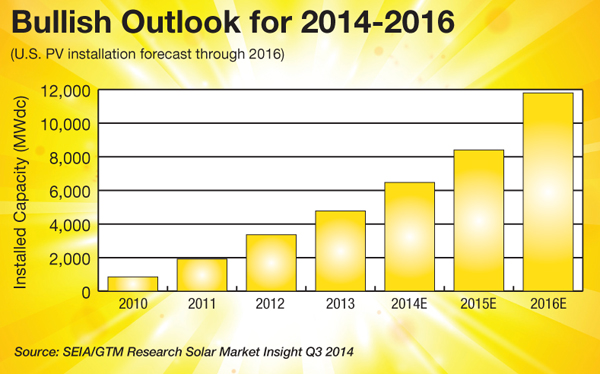Solar Installations: Achieving Grid Parity
Installation of solar photovoltaic arrays is on the rise among commercial real estate properties. Falling prices and growing incentives are even helping solar achieve price parity with utility-supplied electricity.
By Brad Berton, Contributing Editor
 A recent report from Bloomberg New Energy Finance calculated that the solar sector accounted for just under $150 billion in clean-energy investments in 2014—half the global total, and 25 percent more than solar took in the previous year. And it’s expected to continue rising.
A recent report from Bloomberg New Energy Finance calculated that the solar sector accounted for just under $150 billion in clean-energy investments in 2014—half the global total, and 25 percent more than solar took in the previous year. And it’s expected to continue rising.
“Healthy investment in clean energy may surprise some commentators who have been predicting trouble for renewables as a result of the oil price collapse,” Michael Liebreich, chairman of the analyst group’s advisory board, said in announcing the update in early January.
All of which of course brings up the critical but inherently hard-to-address question of “grid parity”: the extent to which the ongoing net benefits of investment in solar photovoltaic arrays make electricity costs competitive with simply buying from the incumbent utility, factoring in any available federal, state and other incentives. As Cory Honeyman, a GTM solar analyst, is quick to acknowledge, market growth in non-residential solar “still remains inextricably tied to the health of incentive levels across a lot of the established state markets.”
Twenty-nine U.S. states now have renewable portfolio standards featuring some form of incentive supporting solar PV development, and another nine have less rigorous related goals. Crunching their data in addition to federal incentives, a recent analysis by Deutsche Bank analyst Vishal Shah determined that solar-generated electricity can achieve price parity with utility-supplied juice in as many as 47 states by the end of 2016, provided Congress extends the 30 percent solar energy tax credit beyond that date.
Even if the credit rate declines 10 percent after 2016 as currently scheduled, the number of states experiencing grid parity should grow from the current 10 up to 36, the analysis concluded. But Jesse Grossman, CEO of Soltage L.L.C., doubts whether Congress will take any action pertaining to extending the investment tax credit this year—and he is far from alone. He will also be keeping a close eye on the Congressional fate of the Environmental Protection Agency’s new Clean Power Plant emissions reduction targets, scheduled for final release this summer.
For more on the anticipated growth in adoption of solar installations among non-residential properties, see “Solar’s Shining Future” in the February 2015 issue of Commercial Property Executive.







You must be logged in to post a comment.